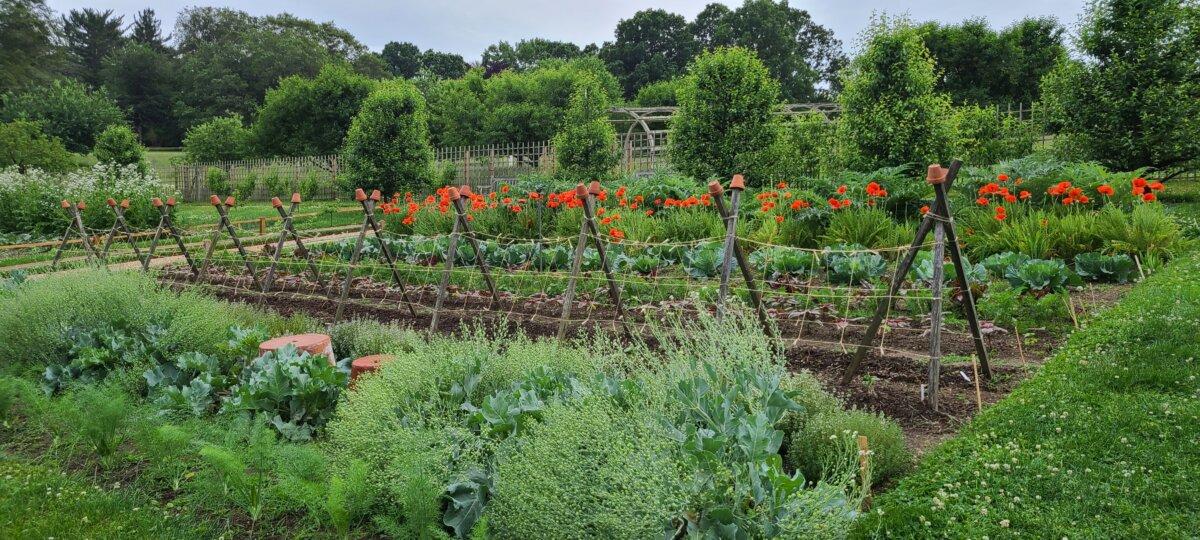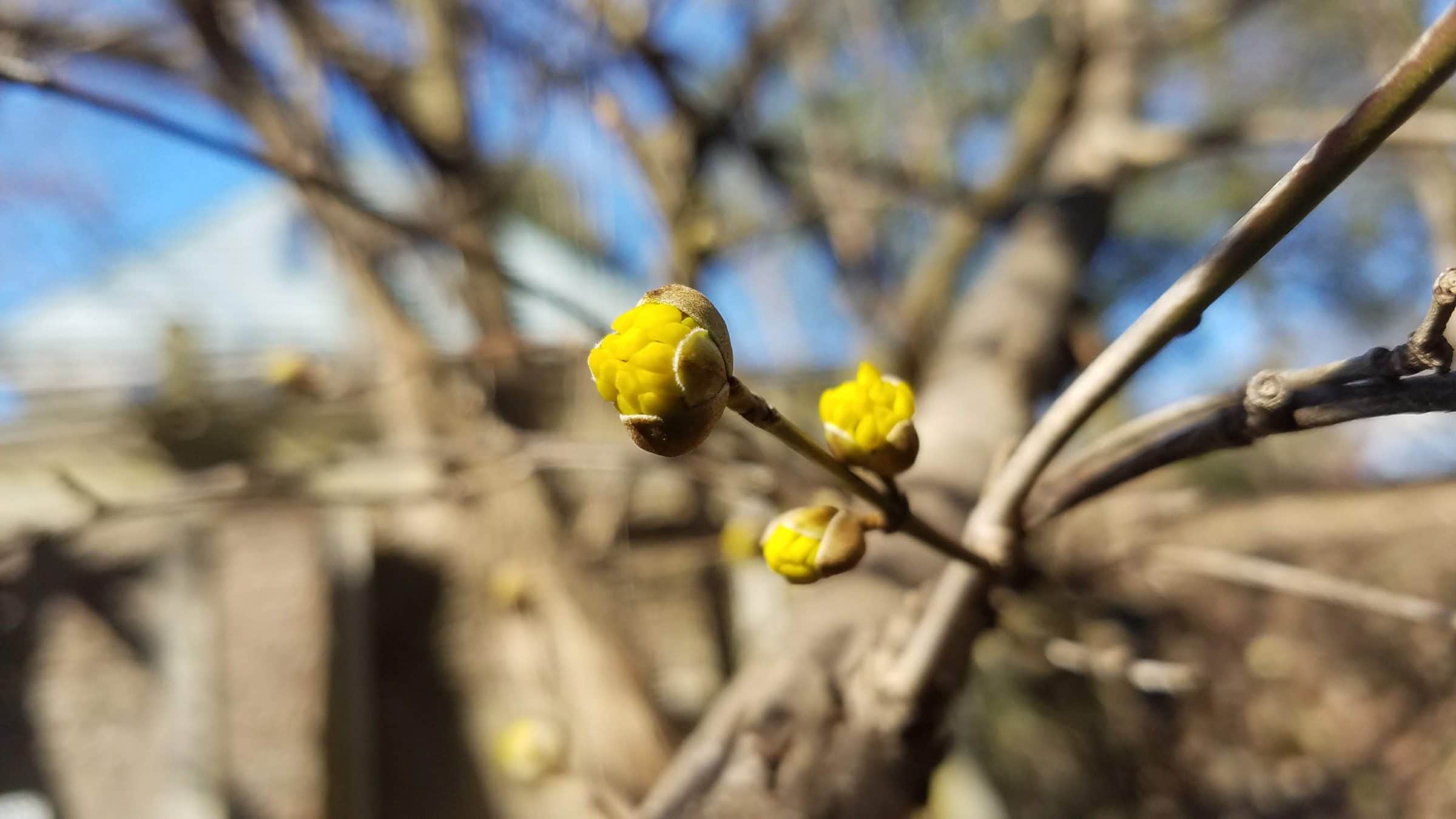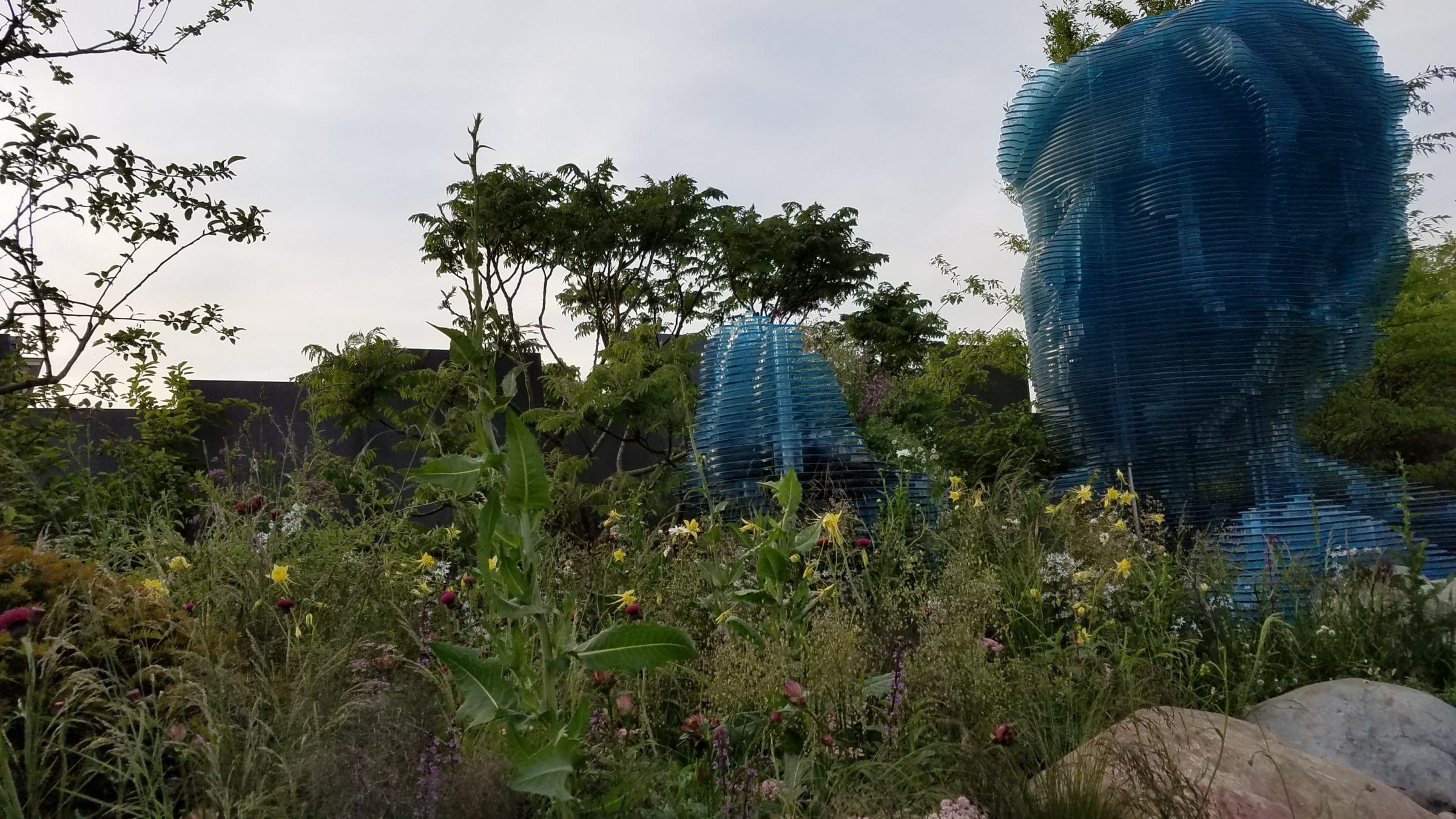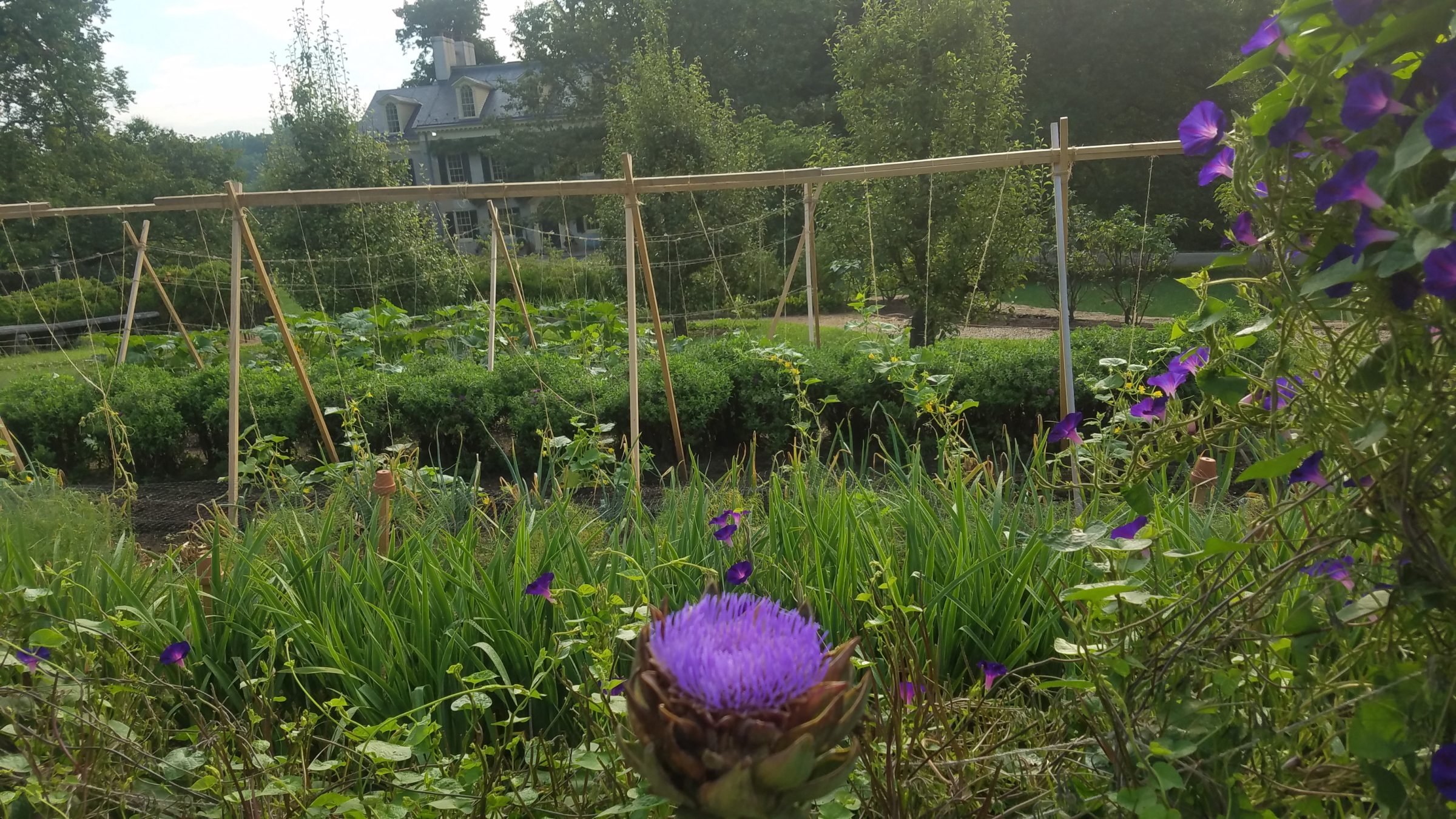
Growing Artichoke in the Kitchen Garden
Background
Although many people are familiar with the taste of artichokes, it seems few are aware of the beautiful plant that produces this delectable food. While tending to the garden at Hagley Museum and Library, I would overhear the tour guides point out the row of artichokes to the guest’s delight. They were genuinely surprised that such a large and unique looking plant is responsible for producing the food they are most accustomed to as a pizza topping or dip ingredient. The intention of this article is to encourage you to grow your own and to give a try at preparing this vegetable in your favorite dish.
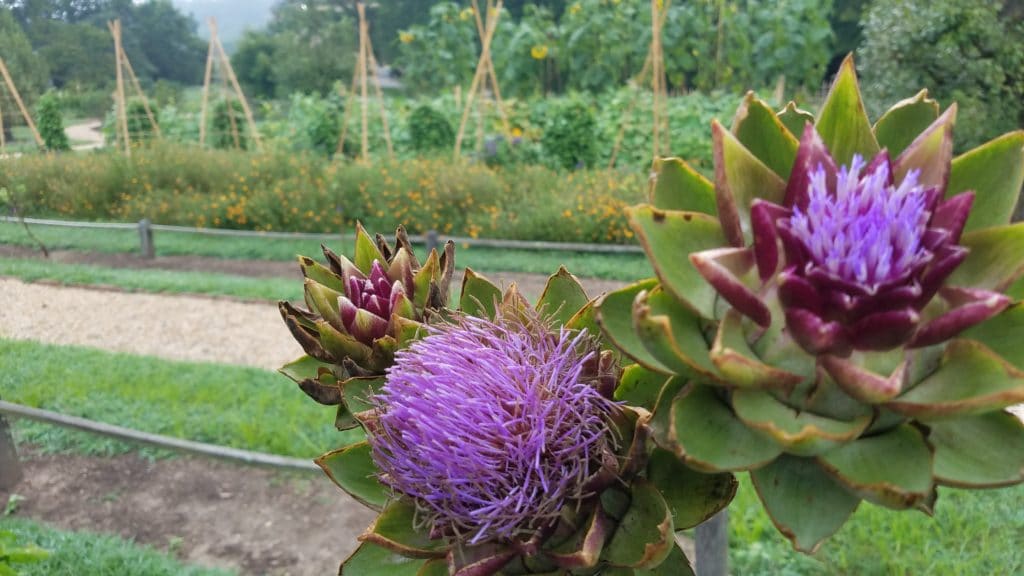
There has been some confusion with the botanical taxonomy of this plant. The artichoke is a cultivated variety of the species Cynara cardunculus, commonly known as the Cardoon. Some sources list the artichoke as Cynara scolymus, and yet some designate it as Cynara cardunculus var. scolymus.

The latter is a more appropriate designation as it infers the natural development of the cardoon without human cultivation. However, once people observed this variety and its larger edible flowers, they began cultivating that variety, creating cultivars such as ‘Green Globe’.
Although not relevant to the growing of the plant, I find the history of how this Mediterranean native migrated to the tables of the United States fascinating (skip ahead for the growing information).
Some of the first records of the artichoke can be traced back to the 8th century BC, where Homer and Hesiod mentioned them as a garden plant in their writings. Cultivation of the wild form of cardoon started in Sicily, beginning during the classical period of ancient Greece, where the stalks and flowers of the improved form where eaten. It continued to be cultivated in Spain after the Muslim conquest of the Iberian Peninsula.
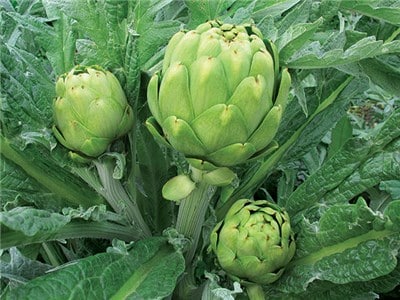
From there, the plant spread among nobles into various countries in Europe. The Dutch introduced the artichoke to England, evidenced by its presence in Henry VIII’s garden in Newhall in 1530. Catherine de Medici of Italy is said to have brought her passion for artichokes to France in 1533 when she was arranged to be the queen of Henry II.
Fast forward a couple of centuries, and the plant migrates to the United States. Thomas Jefferson’s garden notes at Monticello document its presence from 1770 until 1825. This undoubtedly is the reason the French immigrant E.I du Pont had them growing in his garden at Eleutherian Mills in Wilmington, DE. Jefferson and E.I where associates that bonded over their passion for plants, and often sent seeds, scion wood, and other forms of propagative plant material to each other.
Description
To reiterate the distinction between the artichoke and cardoon I will take a passage from ‘The Vegetable Garden’ by MM. Vilmorin-Andrieux, a reference guide of heirloom vegetables and old-time gardening techniques I use religiously.
Notwithstanding the different botanical names which have been given to them, the Artichoke and the Cardoon appear to belong to the same species, cultivation having, in the case of the latter, developed the leaf-stalks, and, in the former, the receptacle of the flower.
The Vegetalbe Garden
Vilmorin-Andrieux, 1981, p.155

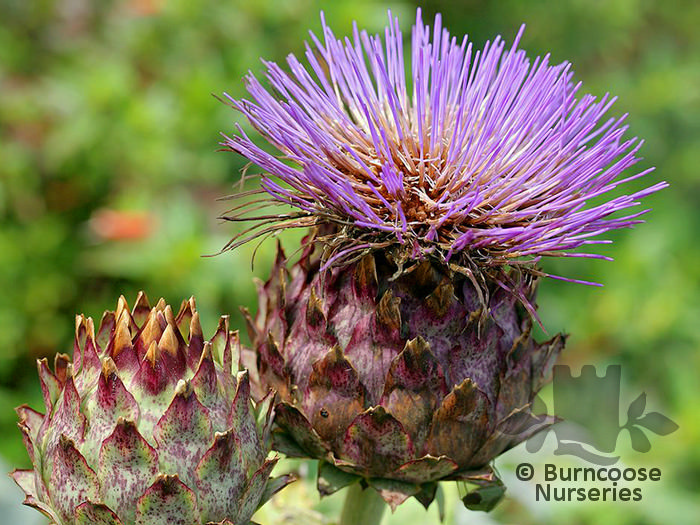
This passage speaks to the basic differences in form and how each plant is utilized differently in the kitchen. The cardoon is taller, with multiple slender stalks that produce many more flowers, while the artichoke that has been bred for its flower, is stouter and produces a larger flower head.

Cynara cardunculus var. scolymus ‘Green Globe’
Origin:
Cynara – derived from the Latin name
cardunculus – resembling a small thistle
Family – Asteraceae
Nativity – Southern Europe / Barbary
Hardiness – USDA Zones 7-9

Description:
Form – Herbaceous perennial 3′-5′ tall with a spread of 3 feet
Foliage – Large pinnatifid with narrow lobing / glaucous on top and cottony underneath / decurrent on the stem
Flower – Terminal flowers arise on long stalks / Each stalk will produce a large thistle-like flower with blue to purplish disc florets that are surrounded with membranous bracts.
Seed – Oblong, somewhat flat and angular/grey to brown colored/roughly 25 seeds per gram/ germination ability stops after 6 years
Culture
Propagation
Artichokes are easily propagated from seed or divisions. One seed supplier I use is Baker Creek rare seeds. https://www.rareseeds.com/store/vegetables/bulk-vegetables/artichoke/green-globe-artichoke

The seeds are sown in the greenhouse in mid-January or direct sown in the garden in early March, depending on the year and soil temperatures. Scheduling this crop accordingly is important as the Artichoke needs to be vernalized for approximately 250 hours at temperatures between 40-50 degrees Fahrenheit to initiate flowering that same season. This year I anticipate planting out the Greenhouse transplants at the end of March.

Growing Season
You can start planting out the transplants once the soil can be worked and the chance of harsh weather has passed. Typically before planting, I try to incorporate either a sterile soil amendment (mushroom compost) or a fertile compost, depending on what was growing there before and the crops nutrient requirements. Work this material in with a tiller, but if you can muster the energy use a broadfork to loosen and turn the soil over.
Give them plenty of space, planting on 36-48in centers. Taper off the initial watering after establishment, keep undesirable weeds from competing with your new transplants, make sure they are getting full sun exposure, and you should see beautiful purple thistle-like flowers in late summer.

Further management will be determined by your garden function. Are you growing a cash crop, or are they strictly grown as an ornamental? Deadheading will be necessary if you want to bring your artichokes to market. Limiting the number of flowers will improve the quality and size of the flowers that you choose to keep. However, if solely grown as an ornamental, deadhead the spent flower heads to encourage a longer display window.
The completion of the flowering period signals another gardening task. If the stalks of the artichoke are also to be enjoyed as a delicacy, the plant should be cut back close to the ground, so as to encourage fresh new stalks to be produced in October. These are then wrapped in burlap or mounded, to create a blanching effect on the stalks. This ‘forcing’ method stimulates sugars in the area cut off from sunlight that produces a much sweeter and palpable taste.
Overwinter
Here in the Northeastern United States(USDA hardiness zone 6b) the Green GlobeArtichoke is treated as a tender perennial. Overwintering success depends on the cultivar, your location, and the methods used for overwintering. Marginal types like Green Globe will require some help getting through dreary Delaware winters, but can also survive if it has been an exceptionally mild winter. For Northern growers, try cultivars like ‘Emerald’ and ‘Northern Star’.

Although sometimes it is just easier to start another crop each year rather than fussing with overwintering methods, I wanted to test out various techniques to see what works best for my particular situation. Certain ones I mounded up with leaf mold and straw, others were tipped and mounded, yet others tipped with their roots wrapped, and some were left as is.

This ‘landing up’ method is most conducive for overwintering artichokes in cold and wet winter climates. The key is to ensure proper drainage and to mitigate the freezing and thawing of the soil. Thus, the landing method has been utilized for centuries to ensure the artichoke survives the winter. After harvesting the blanched stalks the plants are dug up, placed on their sides, and their roots mounded with soil. The following spring the offsprings can be divided from the mother plant and planted back out.
Culinary Use
I’m certain the artichoke would be a much more popular food if they weren’t so difficult to prepare. A skilled chef probably makes quick work of them, but my first try at removing the bracts and chokes proved a tedious process. Once I finally got to the fruit, I threw some slices on a homemade pizza. To give you a better idea of how else to use artichokes, perhaps some of these professional culinary websites would be a better help.
https://www.gimmesomeoven.com/amazing-roasted-artichokes/
https://www.bonappetit.com/recipes/slideshow/artichoke-recipes
https://www.themediterraneandish.com/mediterranean-roasted-artichoke-recipe/
Ornamental Use
Not only are artichoke plants a star in the kitchen, they also have exceptional ornamental value. In the kitchen garden, I use them to draw attention as their height and structural features draw the eye to their stately form. Their presence adds substance, their height adds depth, their color adds contrast, and their magenta flowers add wonder.

I take advantage of the large pinnatifid leaves and glaucus foliage to contrast annuals like Heliotrope, Amaranth, or single black Hollyhocks. Similarly, their broad leaves play well with fine-textured plants like Dianthus, Ammi, and Fennel. They can be used in conjunction with other cool-toned plants to create a cooling effect in a summer garden. For a better display, use Cynara cardunculus.
-Shem
References
VILMORIN-ANDRIEUX, MM. THE VEGETABLE GARDEN. ILLUSTRATIONS, DESCRIPTIONS, AND CULTURE OF THE GARDEN VEGETABLES OF COLD AND TEMPERATE CLIMATES BY MM. VILMORIN-ANDRIEUX, OF PARIS. ENGLISH EDITION, PUBLISHED UNDER THE DIRECTION OF W. ROBINSON , EDITOR OF THE GARDEN. The Ten Speed Press, 1981.
https://en.wikipedia.org/wiki/Artichoke
https://www.victoryseeds.com/artichoke_green-globe.html
https://www.everwilde.com/store/Green-Globe-Artichoke-Seeds.html



